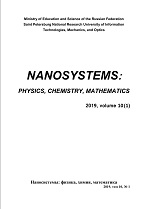|
Papers, presented at NANO-2015
Magnetic silica nanoparticles for the removal of $\mathrm{Pb}^{+2}$ from water
N. Shuklaab, A. Saxenaa, V. Guptaa, A. S. Rawata, V. Kumara, S. Shrivastavab, C. Rajagopala, P. K. Raia
a Centre for Fire, Explosive and Environment Safety, Timarpur,
Delhi-110054, India
b Department of Chemistry, Institute of Excellence in Higher Education, Bhopal-462016, India
Abstract:
Zero valent iron impregnated silica nanoparticles ($\mathrm{Fe}^0/n$-$\mathrm{SiO}_2$) were synthesized using sol-gel process followed by supercritical drying, wet impregnation and hydrogen reduction. The synthesized nanoparticles were characterized by nitrogen Brunauer-Emmett-Teller ($\mathrm{N}_2$-BET), Scanning Electron Microscopy, Transmission Electron Microscopy, Scanning Electron Microscopy with Energy-Dispersive X-ray spectroscopy, Vibrating Sample Magnetometer and X-ray diffraction techniques. Prepared samples were found to be magnetic with ultra-low density ($0.048$ g/mL) and high surface area ($422$ m$^2$/g). Prepared samples were evaluated for adsorptive removal of $\mathrm{Pb}^{+2}$ ($5$, $10$, $25$ and $50$ ppm) from contaminated water. Results indicated that the adsorption of $\mathrm{Pb}^{+2}$ was faster at lower concentrations ($5$ and $10$ ppm) as $>80$ % of $\mathrm{Pb}^{+2}$ was removed within $480$ minutes. At higher concentrations, the adsorption was slower, and the removal efficiency of $51.24$ and $21.78$ % were observed for $25$ and $50$ ppm $\mathrm{Pb}^{+2}$ respectively, whereas for bare $\mathrm{SiO}_2$ nanoparticles, it was $39.64$ and $14.04$ %.
Keywords:
$\mathrm{Fe}^0/n$-$\mathrm{SiO}_2$, $\mathrm{Pb}^{+2}$, removal capacity, removal percentage, pH enhancement.
Received: 23.01.2016
Citation:
N. Shukla, A. Saxena, V. Gupta, A. S. Rawat, V. Kumar, S. Shrivastava, C. Rajagopal, P. K. Rai, “Magnetic silica nanoparticles for the removal of $\mathrm{Pb}^{+2}$ from water”, Nanosystems: Physics, Chemistry, Mathematics, 7:3 (2016), 488–491
Linking options:
https://www.mathnet.ru/eng/nano224 https://www.mathnet.ru/eng/nano/v7/i3/p488
|

| Statistics & downloads: |
| Abstract page: | 60 | | Full-text PDF : | 13 |
|




 Contact us:
Contact us: Terms of Use
Terms of Use
 Registration to the website
Registration to the website Logotypes
Logotypes








 Citation in format
Citation in format 